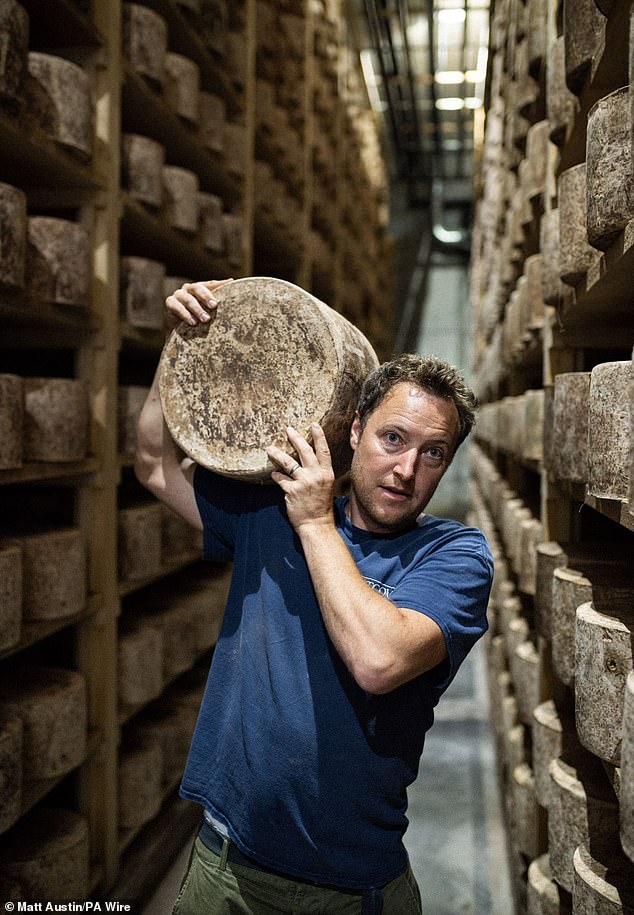It was the most daring heist of the year, if not the decade; a theft so complex and audacious that it left detectives across Europe scratching their heads in disbelief. Each part of the robbery was meticulously organised, from fraudulent paperwork and false identities to the rapid (and untraceable) distribution of the stolen goods – which simply vanished into thin air, never to be seen again.
But the swag wasn’t diamonds or gold bullion, rolled-up old masters or kilos of uncut cocaine – it was artisan Cheddar cheese, 950 wheels of good stuff, reportedly worth up to £300,000, and weighing a mighty 22 tonnes, stolen from Neal’s Yard Dairy in London’s Covent Garden last October.
It’s not just Cheddar. In Italy, according to the Parmigiano Reggiano Consortium, around £5.5 million worth of Parmesan had been stolen in a two-year period leading up to a 2016 heist; they now have to insert tracking devices into the hard rind of each wheel. Cheese larceny is big business. In the past three years, the price of Cheddar cheese in the UK has risen by around 42 per cent, compared to around 20 per cent for food more generally.
Which is bad news indeed, since life without cheese would not just be dull, but unthinkable. I’m addicted to the stuff, once managing to put away 14 plates of melted raclette over a single Alpine lunchtime. Cut me and I bleed fondue. I find it near impossible to wander past the fridge without slicing off a hunk of Mrs Kirkham’s Lancashire, fresh and sweet, with that blissful lactic bite.
Or an oozing wodge of Baron Bigod, all luscious cream, every bit the equal of French Brie. Or Stichelton, a blue cheese beauty, as rich as it is complex. British artisan cheese is some of the best in the world, up there with France in quality and range. We’re in the middle of a British cheese revolution, started by the likes of Randolph Hodgson of Neal’s Yard Diary and Patricia Michelson of La Fromagerie. Blessed are the cheesemakers. And the cheesemongers, too.
So the idea of this everyday staple of the British table becoming a luxury alongside caviar and white truffle is too awful to imagine. But costs are rising. Bobby Bawa, managing director of Foodspeed, a top-end supplier of dairy products to the restaurant and catering business, says that Cheddar prices have ‘followed the general trend of dairy, where milk and butter prices have been rising over the past six months’.
And while milk and cream are more profitable in their raw state, cheese requires extra labour, storage and maturation. Which means more costs for the producer, and smaller margins, too.
‘Prices have definitely soared,’ says Jamie Shears, executive chef of Mount St Restaurant, in London’s Mayfair. ‘You no longer see those cheeseboards with 30 different varieties. We serve four types of British cheese for £28, but don’t see nearly as many sales as a few years back, when a table would order a plate to share.’


Andy Swinscoe, one half of the magnificent Courtyard Dairy cheesemonger in Yorkshire, agrees. ‘Coming out of Covid, restaurant sales of our cheese were strong. But over the past 18 months, belts have been tightening.’
If everyday cheese prices are in the ascendancy, artisan varieties have spiked. Russians and Middle Easterners see proper Cheddar and Parmesan Reggiano as luxury items every bit as covetable as Rolex and Hermès, especially since sanctions in the former have begun to bite. Indeed, it’s suspected that the Neal’s Yard haul made its way to Russia or the Middle East.
The production of artisan cheese is a labour of love. And the creation of an amazing one starts with the way the animals are bred, as well as what they are fed. It can be up to five years before a new cheesemaker gets their product on to the market. Passion comes before profit, and more time spent making and maturing the cheese means more money spent on production. ‘You have to slow everything right down,’ says Swinscoe. ‘I don’t think people appreciate that.’
Cheese shop owner Michelson agrees: ‘Cheese is an emotive thing.’ One of the legends of the artisan world, she started her business in a shed 34 years ago and has seen a ‘vast’ change in perception of proper cheese, every bit the equal of some of the world’s finest wines. As with winemaking, terroir (that combination of soil, topography and climate) is everything. ‘When you make a really good cheese,’ explains Swinscoe, ‘you capture the essence of the place, its very identity.’
Take Somerset Cheddar – Westcombe, Montgomery’s, Keen’s and Pitchfork are clothbound Cheddars created from unpasteurised cow’s milk, made a few miles apart. They all have incredible depth and complexity but markedly different characteristics. Westcombe is relatively mild, with notes of grass and hay, and the most gentle of acidities. Montgomery’s has a beefy, earthy heft, while Keen’s manages to be both creamy and spicy. Pitchfork is lush, sweet and buttery.
It’s these idiosyncrasies that define the brilliance of British cheesemaking. They also make them ripe for international criminal fromage gangs. Patrick Holden is a dairy farmer and cheesemaker, and the man behind Hafod Cheddar, one of the cheeses targeted by the Neal’s Yard thieves. When told that a buyer from a French supermarket was after 22 tonnes of his cheese, he was flabbergasted. ‘It was the biggest order we had ever received – three-quarters of our annual production. At last, I thought, they’re appreciating what we do on the continent.’ But there was no way he could fulfil the whole amount, so 20 tonnes of Westcombe and Pitchfork Cheddar made up the rest. Neal’s Yard Dairy, to their eternal credit, took the full brunt of the loss.
Jamie Montgomery, the cheesemaker behind Montgomery’s Cheddar, admits to being a ‘little irked’ by people complaining about the high price of his produce. ‘I’m not saying there aren’t those people who are hard up,’ he says. ‘Of course there are – but they don’t complain when Netflix goes up, or Sky. Yet they moan about the cost of good cheese.’
Montgomery has a point. In a world where we take cheap food for granted, we seem to have lost any notion of paying more for quality – eating less, perhaps, but eating better. No one moans about a Ferrari being more expensive than a Vauxhall Astra, or Prada costing more than Primark. We’ve become so accustomed to cheap supermarket food, with prices often kept artificially low, that we fail to see its long-term cost will be ruinous, not just to our health, but to the economy.
British artisan cheesemaking is an art – you’re paying extra for years of hard work, knowledge and experience, as well as pure edible delight. As Swinscoe points out, ‘I’m prepared to sell good cheese at that price because it’s worth it.’
British cheesemakers need our support more than ever. Their future depends on us.
TOM’S CHEESE MATHS
If you can still afford it, how to add up the perfect platter
Cheddar + pickled onion + apple chutney
Stilton + walnuts + honey
Mrs Kirksham’s Lancashire + Eccles cake + Branston
Parmesan + balsamic vinegar + pear
Ragstone + gingerbread + peach
Tunworth + quince jelly + grapes
Illustrations: Ellie Allen-Eslor

